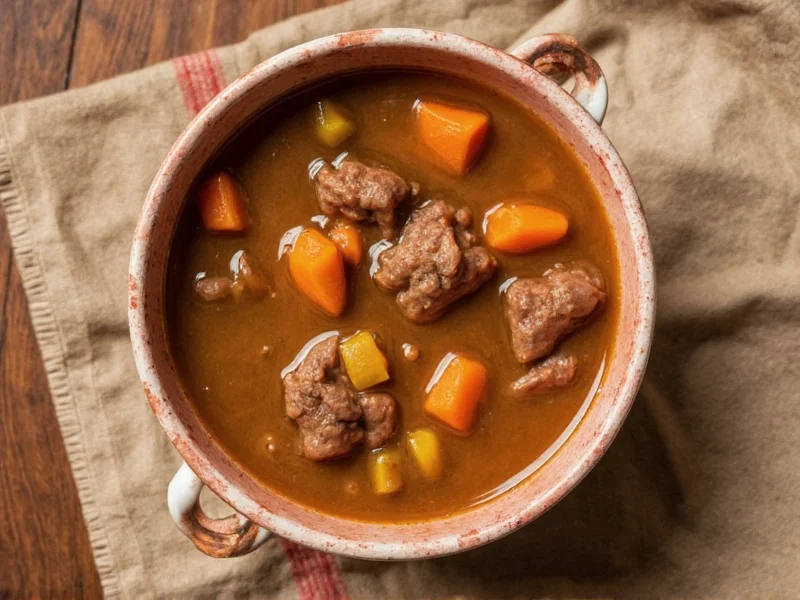When preparing a hearty beef stew, choosing between broth and stock significantly impacts your final dish. Understanding the technical differences between these two foundational liquids is essential for achieving restaurant-quality results at home. While often used interchangeably in recipes, beef broth and beef stock have distinct characteristics that affect flavor development, texture, and overall success of your stew.
Defining Beef Broth vs Beef Stock
Beef broth and beef stock originate from similar ingredients but diverge in preparation methods and final composition. Broth is typically made by simmering meat (sometimes with少量 bones) for 1-2 hours, resulting in a lighter, more immediately flavorful liquid. Manufacturers often add salt, herbs, and seasonings directly to broth, making it suitable for sipping as a standalone beverage.
Stock, conversely, is created through a longer simmering process (6-12 hours) of bones, connective tissues, and少量 meat. This extended cooking time extracts collagen from bones and cartilage, which converts to gelatin. The resulting liquid has a richer body, deeper umami flavor, and superior thickening capabilities—qualities that directly benefit stew preparation.
| Characteristic | Beef Broth | Beef Stock |
|---|---|---|
| Primary Ingredients | Meat,少量 vegetables | Bones, connective tissue,少量 meat |
| Simmering Time | 1-2 hours | 6-12 hours |
| Gelatin Content | Low | High |
| Salt Content | Usually added | Minimal or none |
| Flavor Profile | Lighter, immediate | Deeper, develops with cooking |
| Texture | Thin, watery | Rich, slightly viscous |
| Best For Stews | Quick stews, light broths | Traditional, slow-cooked stews |
Why Stock Outperforms Broth in Stew Applications
The critical difference between beef broth vs stock for stew preparation lies in gelatin content. As stock simmers for extended periods, collagen from bones breaks down into gelatin, which provides natural thickening properties. When incorporated into stews, this gelatin creates a luxurious mouthfeel and helps emulsify fats, resulting in a cohesive sauce that clings to ingredients rather than separating.
Broth's lower gelatin content means stews made with it often require additional thickeners like flour or cornstarch. The added salt in commercial broths also presents challenges—over time, salt concentrates as liquid reduces, potentially making your stew overly salty. Stock's unsalted nature gives you complete control over seasoning throughout the cooking process.
Practical Applications in Stew Making
Consider your stew's cooking method when choosing between beef broth vs stock. For slow cooker stews that simmer for 6-8 hours, stock's gelatin content transforms the texture dramatically, creating that coveted "sticks to your ribs" quality. The extended cooking time allows stock's deeper flavors to fully integrate with other ingredients.
For quicker stovetop stews (under 2 hours), broth might seem convenient, but you'll miss out on the complex flavor development that stock provides. If using broth, look for low-sodium varieties and consider supplementing with additional gelatin by adding a tablespoon of unflavored gelatin powder per quart.
Professional Chef Recommendations
Most professional chefs preparing traditional beef stews exclusively use stock rather than broth. The culinary rationale centers on flavor concentration and texture development. As chef Michael Solomonov explains, "Stock provides the structural foundation that allows stew to develop its characteristic body. Broth is essentially a finished product meant for sipping, while stock is a building block designed to transform during cooking."
A common mistake home cooks make when substituting broth for stock is not adjusting cooking times. Broth-based stews often benefit from a final reduction step to concentrate flavors and compensate for the lack of natural thickening agents.
Creating Superior Stew Liquid at Home
For optimal results, make your own stock specifically for stews. Roast beef bones at 400°F for 45 minutes until deeply browned, then simmer with mirepoix (carrots, celery, onions), tomato paste, and aromatics for 8-12 hours. Skim impurities regularly for a clean flavor. This homemade stock contains 3-4 times more gelatin than store-bought varieties, dramatically improving your stew's texture.
If time is limited, enhance store-bought stock by simmering it with additional bones or connective tissue for 2-3 hours. Even adding a few tablespoons of tomato paste and letting it reduce by 25% can deepen flavor and improve body for stew applications.
When Broth Might Be Preferable
While stock generally outperforms broth for traditional beef stews, there are specific scenarios where broth works better. Lighter stews featuring delicate ingredients like white beans or root vegetables might benefit from broth's cleaner flavor profile. Asian-inspired beef stews often use broth as a base since the flavor profile aligns better with soy-based seasonings.
For emergency substitutions, remember that broth lacks the body of stock. Compensate by reducing the liquid by 25% before adding other ingredients, or incorporate a tablespoon of tomato paste to help with thickening and flavor depth when using broth for stew preparation.











 浙公网安备
33010002000092号
浙公网安备
33010002000092号 浙B2-20120091-4
浙B2-20120091-4